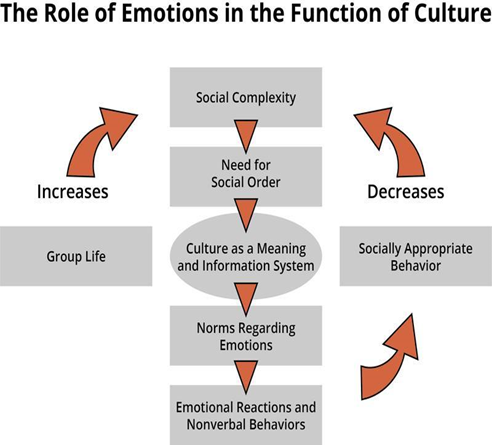15.18: Cultural Elements of Emotional Development
- Page ID
- 140958
Culture and Emotions
Because culture impacts how people display emotion, people from varying cultural backgrounds can have very different cultural display rules of emotion. A cultural display rule is one of a collection of culturally specific standards that governs the types and frequencies of acceptable emotional displays (Malatesta & Haviland, 1982). Some cultural groups appear to express certain emotions more often than other cultural groups (Tsai, Levenson, & McCoy, 2006). Cultural groups also vary by the emotions and emotional states they value (Tsai, Knutson, & Fung, 2006). For example, research has shown that individuals from the United States express negative emotions like fear, anger, and disgust both alone and in the presence of others. In contrast, individuals from Japan only do so while alone (Matsumoto, 1990). Furthermore, individuals from cultures that tend to emphasize social cohesion are more likely to suppress emotional reactions so they can evaluate which response is most appropriate in each context (Matsumoto, Yoo, & Nakagawa, 2008). One study suggests that cultural differences in exposure to specific emotions through storybooks may contribute to young children's preferences for particular emotional states (such as excited or calm) (Tsai et al., 2007).[1]

Cultures also inform us about what to do with our emotions—how to manage or modify them—when we experience them. This often occurs by managing our emotional expressions through cultural display rules (Friesen, 1972). These cultural rules are learned early in life and specify the management and modification of our emotional expressions according to social circumstances. Some are taught to laugh at their boss's jokes even when they are not funny; others learn that "big boys don't cry". Culture affects how individuals express their emotions and how people experience them. Emotional regulation is also influenced by culture and the historical era in which a person lives. This cultural variability in regulation processes is significant (Mesquita & Frijda, 1992). "Cultures vary in terms of what one is expected to feel, and when, where, and with whom one may express different feelings" (Cheah & Rubin 2003, p. 3).[3]

A crucial aspect of culture comes from the transmission of emotional meaning to its members: one way this occurs is through the development of worldviews (including attitudes, values, beliefs, and norms) related to emotions (Matsumoto & Hwang, 2013; Matsumoto et al., 2008). Emotion-related worldviews provide guidelines for desirable emotions, which facilitate norms for regulating individual behaviors and interpersonal relationships. Cultural backgrounds tell us which emotions are ideal and which are not (Tsai, Knutson, & Fung, 2006). The cultural transmission of information related to emotions occurs in many ways, not the least of which is from caregivers to children (Schönpflug, 2009; Tsai, Louie, Chen, & Uchida, 2007). As a caregiver for infants and toddlers, how might your culture's emotional norms conflict at times with the emotional/cultural norms of the children in your care?[4]

[1] California Department of Education (CDE Press). Development Foundations: Social-Emotional Development . Is used with permission
[2] Image by David_Miram is in the public domain
[3] Image by @ablissfulbirth is in the public domain
[4] Hwang, H. & Matsumoto, D. (2021). Functions of emotions is licensed CC-BY-SA

